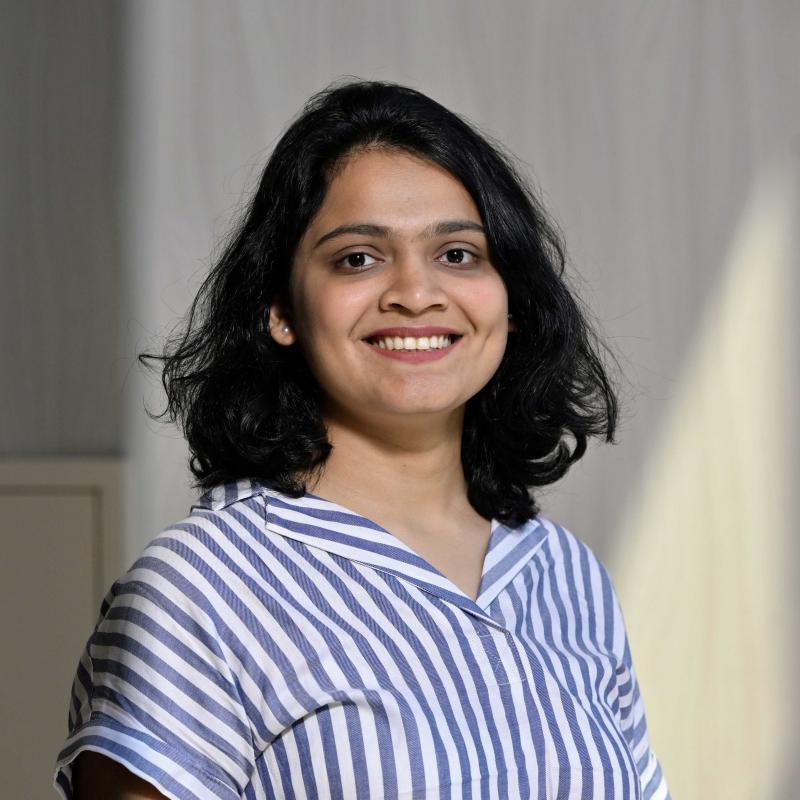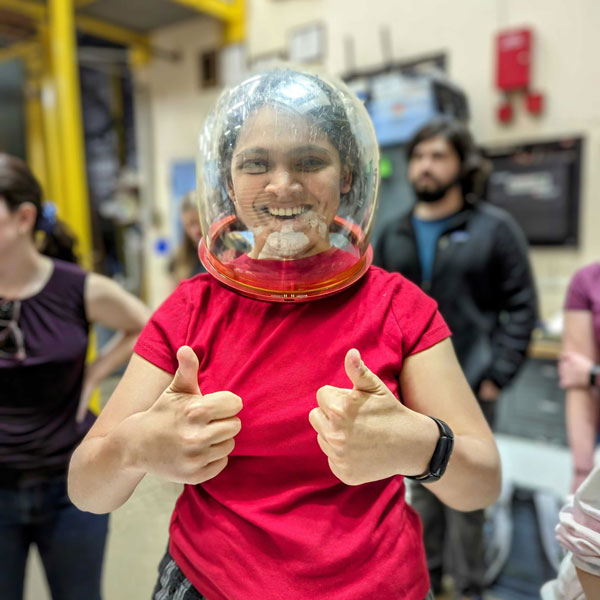
Taking time to see through the learning process is never a wrong thing to do but is rather very advised.
This semester we are introducing a Q&A style profile series to highlight our students, and share their inspirations, aspirations, and motivations.
This month, meet aerospace engineering senior, Kruti Bhingradiya, from Surat, Gujarat (India). She is also the current president of UMD’s student chapter of AIAA (American Institute of Aeronautics and Astronautics).
Why did you choose to study Aerospace Engineering?
My passion for science found its place within the application for one of the most challenging horizons humanity is trying to explore, space.
When I read Pale Blue Dot by Carl Sagan, the fact that our existence is so insignificant, and we are yet to find something like this in the known universe not only intrigued me but also made me want to be part of and contribute to the exploration and research. I was going to pursue astrophysics but the realization that it is applications of scientific discovery and innovation from the first principles of science which inspire me more than just the theoretical physics and math was what determined my choice of major.
I love space and I love engineering and when the time came, I knew what to choose.
Why did you choose to come to the University of Maryland for Aerospace Engineering?
I am from this city in Gujarat, India where Internet wasn't accessible. To research for our school projects, my friends and I used to go to cyber cafes and print out webpages to read through them. However, in 2016, it became accessible after one company started giving 1 GB of free internet every day.
It was around that time I came across podcast called "Making Space a Female Frontier.” After listening to a podcast about the Mars Helicopter Ingenuity, I learned that it was written in 2000 by a grad student for a student competition from University of Maryland (who now is a professor in department). That is when I first came across UMD and went through their aerospace engineering website. The research facilities and the aerospace labs where they were pursuing very interesting research. The Space Systems Lab, the Rotorcraft Center, and the Maryland Robotics Center seemed like some of the best across other schools I was looking at, so when applying for college, the University of Maryland Department of Aerospace Engineering was one of my top choice schools.
What student groups or clubs are you a part of, if any, and what do enjoy about them?
I have been part of Near Space Balloon Payload Program (BPP) since my freshmen year. The thing that I enjoy most about the program are the launches. Every month, we launch a high-altitude weather balloon to near space with various different payloads to gather atmospheric data and test prototypes of mechanisms. It is during these launches that we get to test the systems in flight that we have designed and built. It is very rewarding to see the payloads we have worked on perform the intended task successfully and gather good data. The other aspect of launches is that the mission operations are conducted like a space mission and being in different roles like Flight Director, Telemetry Officer, Command Module, Launch Director, Radio Officer etc. is very fun.
I have also been involved with AIAA (American Institute of Aeronautics and Astronautics) since my freshmen year and am the President for the UMD Chapter this year. It was through AIAA that I came across all the opportunities I have had in college—be it research or internships—and it is a way for me to give back to the aerospace community.
I am also an active member of Women in Aeronautics and Astronautics and vice-president of SGT (Sigma Gamma Tau, the Aerospace Engineering Honors Society)
What are your post-graduation plans?
I am planning on going to grad school for space robotics.
What advice would you offer others who might be interested in pursuing aerospace engineering?
People often say that aerospace is hard which might sway the choice you are about to make in terms of pursuing engineering, but what I have learned from my experience is that nothing is really hard. It is just a matter of knowing how to do something and not knowing the same.
Of course, the process of learning how to do a few things could be longer than other things, but the only way to know something is by going through it. Taking time to see through the learning process is never a wrong thing to do but is rather very advised.
Where I am from, it was always a challenge to find opportunities, let alone get them. When I decided to pursue aerospace engineering, the common perception was "you don't know what you are talking about.” After all, I was just a 16-year-old thinking about moving across the world to pursue something which for some people didn’t seem to even be a real thing. I was 17 when I got accepted to school and decided to come here, and many thought it would be almost impossible to get any opportunities as I am an international student.
It was my determination to learn which brought me opportunities and continuous support of the Aerospace Engineering Department, my advisors Dr. Derek Paley, Dr .Mary Bowden and Dr. Alison Flatau, that when I came across such opportunities, I was able to find suitable resources to pursue them.
Often times, we are so absorbed in the disappointments that the opportunities seem to blur out. It is during the time of these deepest disappointments that I have found my way through. It was not despite the lack of these said opportunities, but because of it that I found the ones I did.
At times when standing at the end of the road which has not been walked on for a while and when the options are to turn back or go through, going through is what has made a difference for me.
What do you do for fun?
I love conducting outreach. As Lab Coordinator for Terrapin Works, I am working with Women in Engineering to devise workshops for the incoming freshmen women and gender minorities in engineering so they can have more hands-on experience with electronics, software, 3D printing, and subtractive manufacturing.
Do you work in any labs? If so which one(s) and what is the coolest or most interesting thing you have done so far?
I work in Collective Dynamics and Controls Lab under guidance of Dr. Derek Paley on hydrodynamics modelling and controls of pair of fish robots. I am also part of the Near Space Balloon Payload Program where I am developing a venting system with a team of five other peers which has enabled floating of high-altitude weather balloon in the near space environment.
Last year, I conducted research at NASA's Jet Propulsion Laboratory as a visiting researcher where I was developing and testing robotic micro-swimmers to continue space exploration of extraterrestrial ocean worlds especially Enceladus, Europa and Titan. These micro-robots(swimmers) will help in active sampling of ocean water which is beyond reach of SESAME (Scientific Exploration Subsurface Access Mechanism for Europa) class drilling robots thereby helping scientists characterize alien ocean's composition and habitability. This was so far the coolest project I have worked on in terms of its application. My experience with underwater robots directly correlated to my research at JPL and the design and testing skillset I acquired as a part of BPP came in clutch.

Kruti in the University of Maryland's Space System Laboratory "demonstrating" an Apollo-era spacesuit helmet.
Top